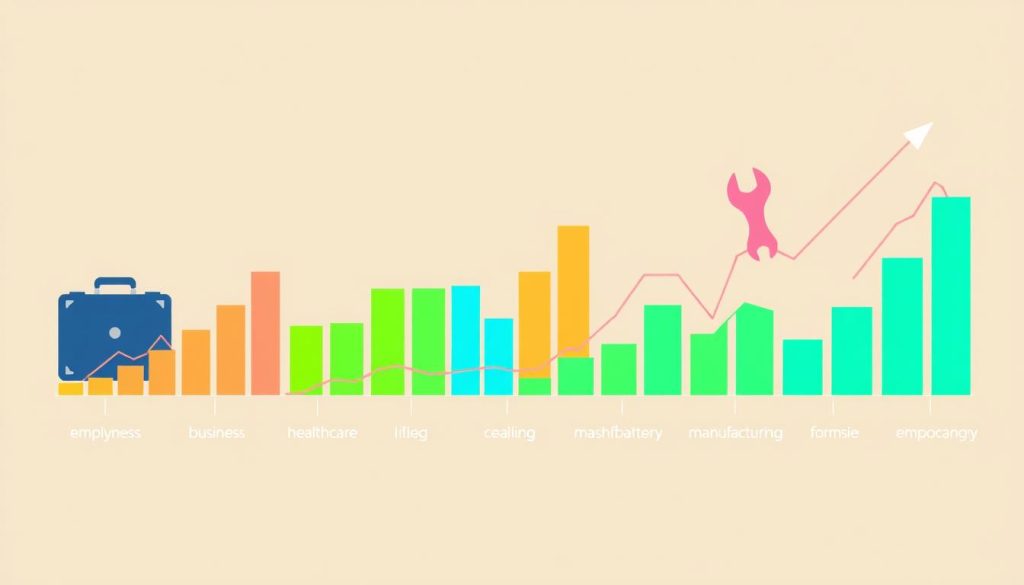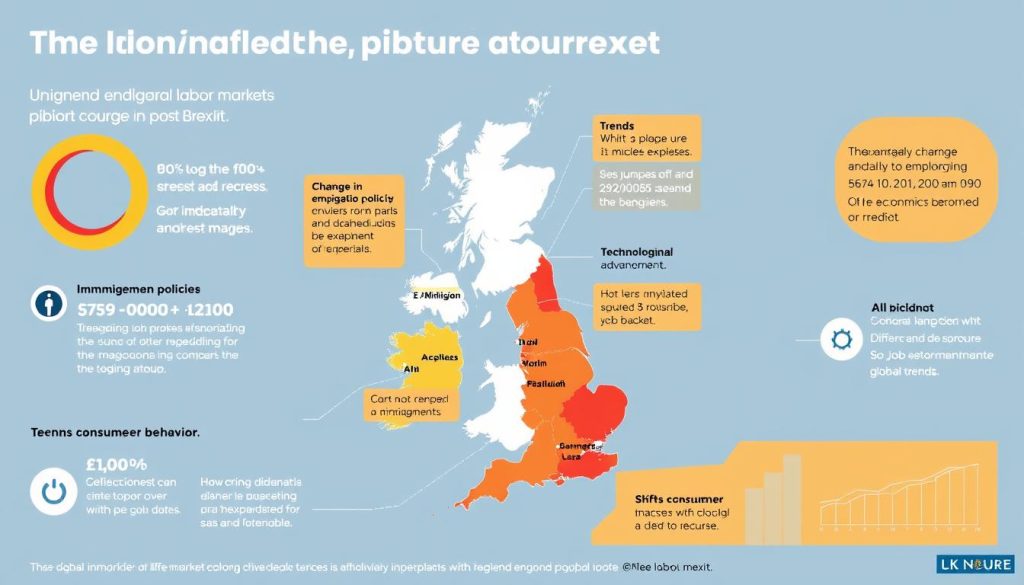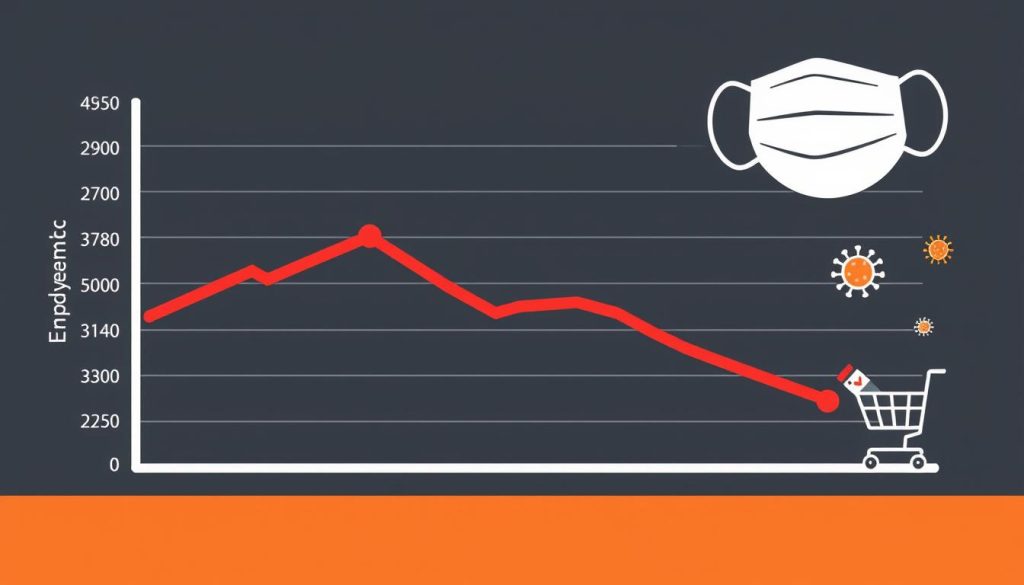Is the UK’s job market truly recovering, or is this just a short-lived improvement? Economists are keenly observing employment figures, workforce plans, and how these affect the economy. This topic is getting a lot of attention.
We aim to thoroughly explore the UK’s employment scene. We’ll look at how job rates change, what drives workforce strategies, and connect it all to the economy. With data from the Office for National Statistics (ONS) and top economic experts, we’re ready to dive into the UK job market’s key issues.
Introduction to Employment Levels
Understanding employment levels is key to assessing an economy’s health. Economists and policymakers look at the employment rate to understand the job market’s strength. They use data like workforce demographics and job sector stats.
Many things shape employment patterns, like new tech, changes in what people buy, and global economy shifts. Experts study these patterns through labour market analysis. This helps show how different job sectors affect the overall employment rate.
It’s vital to know about the workforce’s makeup for good labour market analysis. Things like age, gender, education, and where people live make a big difference in job trends. Groups like the UK Labour Market overview give important data for this analysis.
Understanding these basics helps make policies to boost the employment rate and grow the economy. Next, we’ll look at how different sectors and outside factors change the UK’s job scene.
Historical Trends in UK Employment

The evolution of the UK’s work scene shows big changes over years. Delving into job market history shows how ups and downs and tech advances help us understand shifts in jobs today.
Post-World War II Job Market Changes
After World War II, the UK’s job scene changed a lot. Thanks to new social policies and making key businesses public, more jobs appeared, mainly in government services. These developments set the stage for today’s job world and shaped job trends back then.
Impact of Economic Recessions
Economic slumps have often hit UK jobs hard. Tough times, like the 1970s oil shock and the 2008 financial crunch, led to more ups and downs in jobs. These periods of loss in various areas show the job market’s ups and downs over time.
Technological Advancements and Employment
New technology has always changed jobs, bringing new ones and ending others. The tech boom has made the need for fresh skills crucial, changing many industries. From robots in factories to new IT jobs, technology has steered job trends throughout history.
Sector-Specific Employment Insights

Looking at employment trends in different sectors helps us understand the UK job market. Each sector plays a unique role in the job scene. They are influenced by various factors and changes in the economy.
Manufacturing Sector Employment Trends
Manufacturing jobs have seen big changes in recent years. There’s a move towards using more robots and high-tech methods. Data from the Office for National Statistics (ONS) shows less traditional manufacturing jobs but more need for special skills and precision. This change needs people to learn new skills.
Service Sector Growth and Job Creation
The service sector is vital for creating jobs in the UK. It employs almost 80% of the workforce. Growth in finance, healthcare, and IT is driving this. Despite fewer manufacturing jobs, the service sector is offering new, exciting job opportunities. The growth here is essential for the economy to stay strong.
Emerging Industries and Job Markets
New industries are changing the job landscape. Renewable energy, biotechnology, and digital media are key areas. Economic research shows these new markets are important for job stability in the future. They open doors for new skills and innovation. Focusing on these areas keeps the UK competitive worldwide and prepares the workforce for the future.
Impact of Globalisation on Employment Levels

Globalisation has changed UK employment a lot. It has done this through offshoring and outsourcing, trade deals, and immigration. We’ll look closely at how these factors work together and affect jobs.
Offshoring and Outsourcing
Many UK companies have moved their work abroad to save money. This has shifted jobs from the UK to other countries. Although this helps businesses save money, it can lead to fewer jobs back home.
International Trade Agreements
Trade agreements play a big role in UK jobs. They make it easier to trade with other countries. But they also bring challenges, like tough competition, which can threaten jobs. By understanding these deals, we can see their true impact on work.
Immigration and the Labour Market
Immigrants are important for the UK economy. They bring valuable skills and help the job market adapt. Yet, this can also push wages down in some cases. It’s important to look at both sides to truly understand immigration’s effect on jobs.
So, globalisation affects employment in many ways. To understand it all, we need to think about the impacts of offshoring, outsourcing, trade, and immigration. All of these shape the UK job market today.
Role of Government Policies

Government policies are key in shaping UK employment. Authorities use labour policies and employment laws to affect job levels and market trends. Economic policies show their power through job growth and economic stimulation initiatives.
Job creation programmes are a main way to boost employment. These initiatives offer benefits like financial aid and tax cuts to encourage companies to hire more people. By helping employers, the goal is to make a strong job market for long-term economic health.
Protecting workers’ rights is vital, too. The UK has made many laws to improve job security, wages, and workplace safety. These laws are critical for a fair and trustworthy job market.
The Minimum Wage Act ensures workers get a fair wage. The Health and Safety at Work Act makes workplaces safer. The Equality Act fights workplace discrimination, supporting diversity.
Also, the government promotes skill development. It invests in training to prepare the workforce for future job needs. This boosts workers’ job chances and aids industries seeking skilled labour.
In summary, governmental actions in labour policies, laws, and economic measures are crucial. They greatly influence the job market, aiming for a dynamic and inclusive economy.
The Gig Economy and its Effect on Employment

The gig economy is changing how we think about jobs. People and businesses now prefer short-term jobs and freelancing. This shift brings new ways of working and impacts jobs everywhere.
Rise of Short-Term Contracts
More and more jobs are now short-term contracts. Businesses like them because they can adjust their workforce fast. This flexibility means companies can easily grow or shrink their teams as needed.
Technology, creative fields, and services are where you see a lot of these short-term contracts. People working these jobs enjoy the variety, learn new skills, and control their schedules better.
Freelancing and Self-Employment
Freelancing stands out in the gig economy. More professionals now choose to work independently. Websites like Upwork and Fiverr help freelancers find work all over the world.
More people now start their own businesses or offer unique services. Freelancers love setting their own rules, picking projects that excite them, and finding a good work-life balance. This move to self-employment is changing the job market and how businesses find and hire talent.
Overall, the gig economy makes the job market more flexible. It opens up new chances for both workers and businesses.
Employment Levels and Economic Indicators

It’s important to grasp employment levels when looking at key economic indicators. These indicators show how healthy the job market is. They are detailed in reports on economic performance.
unemployment rate tells us about the economy’s health. A low rate means the job market is strong. A high rate might signal economic troubles. Analysts use data from the Office for National Statistics (ONS) and research on the labour market for insights.
Economic performance is often measured alongside employment levels. For example, we look at GDP growth and productivity. The workforce analysis checks how many people of working age have jobs or are looking for work. This info shows job availability and the economy’s overall health.
In conclusion, understanding employment and economic indicators is key. This helps us get the full picture of the job market and its effects. Keeping an eye on these indicators is crucial for everyone, from government officials to economists.
Post-Brexit UK Labour Market

Brexit has deeply changed the UK job scene, leading to a big shift in employment. New laws are being made to help businesses and workers adjust to life after Brexit. Companies are trying to keep skilled staff while following new immigration rules.
Manufacturing and agriculture used to depend a lot on EU workers. Now, they’re running short on staff. Businesses are looking for new ways to hire people. They’re investing in local talent and using more machines.
New employment laws are also important in this new era. They’re making sure workers are treated fairly. At the same time, businesses need to stay ahead globally. These laws are changing things like job definitions, pay, and safety at work.
The changes have left many EU citizens unsure about living in the UK. This means companies need to train UK workers more. The effects of Brexit are not just about numbers of jobs. They’re also about how the UK’s work scene is evolving in bigger ways.
- The shifting demographics due to the EU workforce transition.
- Complexities in retaining talent amid changing immigration policies.
- Significant labour shortages in traditionally EU-reliant sectors.
The UK must keep an eye on these issues and adapt. This will help maintain a strong and flexible job market after Brexit.
The Role of Education and Skill Development

Education and skills are key to job prospects in the UK. Job markets change fast. Our education must adapt, offering both academic and vocational paths. This helps bridge the skills gap and creates a skilled workforce.
Importance of Vocational Training
Vocational training is crucial for job chances. It gives practical skills needed in many jobs. This kind of training closes the skills gap, leading directly to jobs. It focuses on key skills, preparing workers for today’s job market.
Higher Education and Job Market Alignment
Higher education must match job market needs. Courses should evolve with industry demands, making graduates ready for jobs. This link between education and jobs helps graduates and grows the economy. It gives businesses the skilled people they need.
Continuous Professional Development
Keeping skills up-to-date is vital in a fast-moving job market. Professional training programmes help people progress in careers. It fills the skills gap and encourages lifelong learning. This builds a versatile and resilient workforce.
Skills development, vocational training, and ongoing education are vital. Together, they build a strong job scene, boosting the economy and helping careers.
COVID-19 Pandemic and Employment Trends

The COVID-19 pandemic changed the job world a lot. It caused many people to lose their jobs and made us see how important it is to have a strong job market. Companies and whole economies had to quickly figure out how to deal with this crisis. This showed how jobs can change and what we need to think about for the future of work.
Immediate Impact on Jobs
Jobs took a big hit right away due to COVID-19. A lot of people were suddenly out of work or on temporary leave. Especially hard hit were the places where you go out to eat, travel, or shop because of lockdowns and the need to stay apart. This led to more people without jobs and a big change in job markets all over the world.
Long-Term Employment Projections
In the future, how quickly jobs come back will vary by industry. Some areas are bouncing back fast, while others might struggle for a while. The speed of recovery will rely on things like how many people get vaccinated, what actions governments take, and how the world’s economy does. To help jobs recover and keep the economy stable, making the job market stronger will be key.
Technology and Automation in the Workforce
In recent years, automation has transformed many sectors. It’s vital to grasp the impact of technology in jobs. Advances in AI and machine learning are changing how we work. This change has both good and bad points for workers and bosses.
Automation is especially noticeable in making things, where robots do routine jobs. Now, humans do more creative work. Siemens says AI is playing a big role in their business.
The service industry is also seeing more AI, like chatbots for customer help. People need to learn new skills to work well with machines. This is a big shift.
The World Economic Forum says learning new skills is key. Workers must keep up with changes by learning. Schools and companies must work together to make training fit today’s jobs.
Technology and automation are changing jobs a lot. To do well in the future, we must use AI and learn from it. This is how we will succeed.
Regional Employment Disparities in the UK
In the UK, tackling differences in job rates between areas is key. We see a big gap between job rates in city and countryside. Looking into these differences sheds light on what needs to change.
Urban vs Rural Employment Rates
Cities in the UK have more jobs compared to rural areas. This is because cities have more people and different kinds of businesses. Even though countryside areas may do well in farming and tourism, they often have fewer jobs.
The gap in job rates comes from various reasons. Cities attract more money, which leads to more jobs. Countryside areas, lacking in services and infrastructure, find it harder to create jobs. This shows we need a plan that helps both city and countryside grow.
Impact of Regional Development Funds
Funding aimed at reducing job gaps is vital. Such funds improve infrastructure, offer business perks, and support training programs. This boosts employment in local areas.
Case studies in the UK highlight the success of these funds. Areas with more funds see better job rates and economic growth. These efforts close the job gap between cities and countryside. It shows the power of smart investments in solving job differences.
Employment Levels and Social Inequality
Exploring disparities in employment helps us understand UK’s social inequality better. Factors like gender, race, and socio-economic status affect job chances. We’ll look into the gender job gap, racial employment disparity, and the impact of socio-economic status.
Gender Employment Gap
The gender job gap is a big issue in the UK’s work environment. Although there’s some improvement, women face hurdles in getting the same jobs as men. The “Gender Pay Gap Reporting” by the Government Equalities Office tries to fix these issues, but progress is slow.
It’s especially bad in tech and engineering. In these fields, women are much less common than men.
Racial Disparities in Employment
Racial employment disparity also affects job equality. Studies by the Runnymede Trust show that ethnic minorities often have higher unemployment and get paid less than white people. This situation calls for actions to make workplaces more diverse and welcoming.
Employers need to knock down the barriers causing these disparities.
Socio-Economic Status and Job Opportunities
Your socio-economic status can greatly influence job access. Those from poorer backgrounds find it harder to get good jobs. Education, networking, and where you live play roles in this issue.
The Social Mobility Commission works to solve these problems. Their goal is to make the job market fairer for everyone.
Future Projections for UK Employment Levels
The way we look at jobs in the UK is changing due to various factors. Experts think that while some jobs might reduce because of robots and smart technology, other areas will grow big. We’re seeing a move towards jobs in digital areas and green industries. This change comes from what people want and government plans for a clean environment.
There’s going to be a big need for people with top skills, especially in IT, clean energy, and health jobs. It shows how important it is to keep learning new things to fit into this changing job scene. Jobs of the future will also need more hands-on training to fill in any skill shortages.
Reports on economic growth suggest some places might get left behind if we’re not careful. Places that have always made things the traditional way could lose jobs. To stop this, there has to be big investment in schools, better roads, and new ideas. This will help make sure all parts of the UK have good job opportunities.











